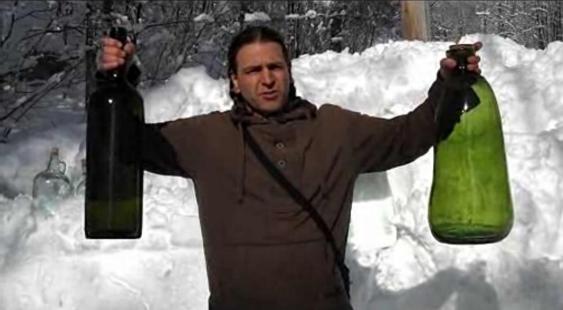
Daniel Vitalis explains the benefits of using dark glass to store water on Findaspring.com.
Over the last few years, health advocates such as Daniel Vitalis have been encouraging people to seek out natural spring water. The stuff that comes bubbling out of the ground into your own container; not the artfully packaged product shipped from exotic locations to your supermarket shelf. This is a good thing, as Daniel explains on his very useful site Findaspring.com (link below).
In addition to the huge waste problem, there is now strong awareness of the chemical leaching that occurs when water is stored in plastic bottles for long periods without refrigeration. There are also studies showing commercial filtering causes some breakdown of the minerals and other nutrients in the H20 – although this shouldn’t be a problem if you eat a healthy diet. But if you want to drink spring water, it is important to know the source is reliable.
While this may seem beyond obvious, many people don’t really appreciate how easily agricultural and industrial runoff can seep into groundwater. In Japan, there is a long tradition of using and drinking spring water for its health benefits. Many people plan regular trips to soak in onsen hot springs or fill containers at sources believed to have curative properties. These places are usually closely monitored but people also often fill bottles at, for example, inner-city sources – something that requires more care.
Here in Kyoto, I often see brave souls collecting water at a source in the Imperial Park. This is a large chunk of land, however, it is also right in the middle of a big, old city with major construction and industry. The situation in Kyoto, and many Japanese cities, is fairly unique, with a very high rate of building replacement. Zoning laws are also a relatively new idea so you often see houses with workshops or small factories on the ground floor in the middle of residential neighborhoods.
This means, for example, that each time a new structure is built, pollutants from concrete, roof sealants, paints, etc. are washed into the drains and soil when it rains, where they join waste disposed of by the many small businesses around town. This chemical brew then potentially leaches down to the water table to be shared across the city.
It’s a similar story in the surrounding land. My impression is things have improved greatly but waste dumping used to be a major problem in Japan. Even now it’s not uncommon to come across illegal dumps or suspicious-looking containers while hiking. With Japan being a hot, humid insect paradise in Summer, huge amounts of chemicals are also used to grow commercial crops, which puts a lot of highly dubious substances into the environment.
This is not to put you off – as you’ll appreciate when you taste live spring or stream H20. Once you get up above the level of farm land, the flow should be clean. Naturally, drink from moving rather than still sources to avoid parasites. If you are in Kyoto, Fushimi has been famous for its pure water for centuries. There is actually a free source right in Kizakura sake brewery. Yes, the brewery is in town but this is the water that goes into Kizakura’s world-famous beverages.
Other details and resources
Main map page of Findaspring.com
Please note that Findaspring.com is a user-submitted database and does not test water itself. Laboratory testing is the only way to ensure a source is completely clean but recommendations from people who regularly drink the water are a good guide.

I try also the water at the Kyomizu temple. It taste good to me but have worry a little about pipe.
It’s true, Rainer. Some of the pipes used in Kyoto are still quite old. Awareness of such things doesn’t seem to be high here. But in the case of Kiyomizu, I think you should be fine. A high volume of water passes through the system each day so the pipes should be clean, particularly if you only drink once.